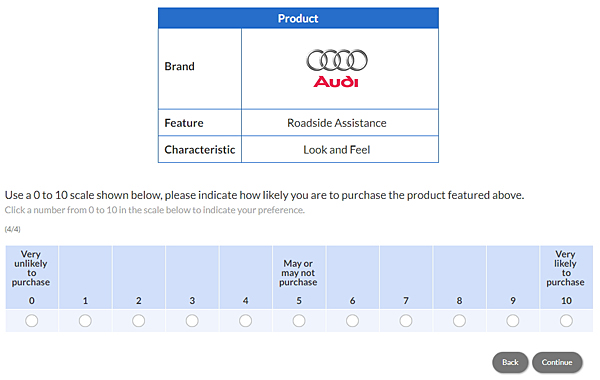CBC (Choice-Based Conjoint)
Choice-Based Conjoint (CBC) is used for discrete choice modeling, a research technique that is now the most often used conjoint-related method in the world. The main characteristic distinguishing choice-based from other types of conjoint analysis is that the respondent expresses preferences by choosing from sets of concepts, rather than by rating or ranking them. The choice-based task is similar to what buyers actually do in the marketplace. Choosing a preferred product from a group of products is a simple and natural task that everyone can understand.

CBC is often used to study the relationship between price and demand, and is especially useful when the price-demand relationship differs from brand to brand, and when only a few features need to be considered. One of the strengths of CBC is its ability to deal with interactions, such as when different brands have different sensitivities to price changes. Most conjoint methods are based on “main effects only” models that ignore the existence of such interactions. In contrast, CBC may be used to evaluate all two-way interactions.
The researcher must decide on attributes and their levels, and compose whatever explanatory text is desired for the interview screens. Apart from that, everything can be done automatically. The CBC System provides all the tools needed to conduct a choice-based conjoint study via Web, CAPI (PCs not connected to the Web), or paper-based surveys. Our CBC system includes three analysis modules and a market simulation module for testing “what if” scenarios.
CBC data can be analyzed in a number of ways. First, the relative impact of each attribute level can be assessed just by counting “wins.” In randomized CBC designs, each attribute level is equally likely to occur with each level of every other attribute. Therefore, the impact of each level can be assessed by counting the proportion of times concepts including that level are chosen. This “counting” method can be used for main effects as well as for two- or three-way interactions. For a second type of analysis, CBC includes an easy-to-use module to perform multinomial logit estimation. This analysis results in a set of conjoint “utilities,” but which differ from standard conjoint in that they describe preferences of a group rather than for an individual. CBC’s Logit module can estimate main-effects and two-way interactions. The output is used by the market simulation module, which estimates the share of choice for products that are made up of combinations of the study’s attributes.







































